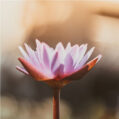Osho’s ashes are brought to Osho Commune International two days later and placed in His samadhi in Chuang Tzu Auditorium with the inscription:
OSHO
Never Born
Never Died
Only Visited This Planet Earth Between
11 December 1931 – 19 January 1990


Osho is born in Kuchwada, a small village in the state of Madhya Pradesh, central India. He is given the birth-name Rajneesh Chander Mohan. By the 1960s Osho is known as Acharya Rajneesh. By the 1970s he is Bhagwan Shree Rajneesh, and finally he is known as Osho by 1989 onwards.
Osho says of his parents: “I had chosen this couple for their love, their intimacy, their almost one-ness.”

Following the death of his paternal grandmother, Osho is sent to live with his maternal grandparents. They provide him with an extraordinary atmosphere of love, freedom, and respect. This by his own accounts, is a major influence in his development and his nature to boldly question and challenge everything for the sake of truth

When Osho is seven years old, his maternal grandfather dies with his head in Osho′s lap as they travel in the back of a bullock cart on the long journey to reach the nearest doctor. This has a profound effect on his inner life.









































Osho’s ashes are brought to Osho Commune International two days later and placed in His samadhi in Chuang Tzu Auditorium with the inscription:
OSHO
Never Born
Never Died
Only Visited This Planet Earth Between
11 December 1931 – 19 January 1990
OSHO is a registered trademark of Osho International Foundation, used with permission, www.osho.com/trademarks. Some material used here (images and text excerpts) is Copyright ©️ OSHO International Foundation www.osho.com/copyrights.



604-537-4306
info@rajivhomes.com
